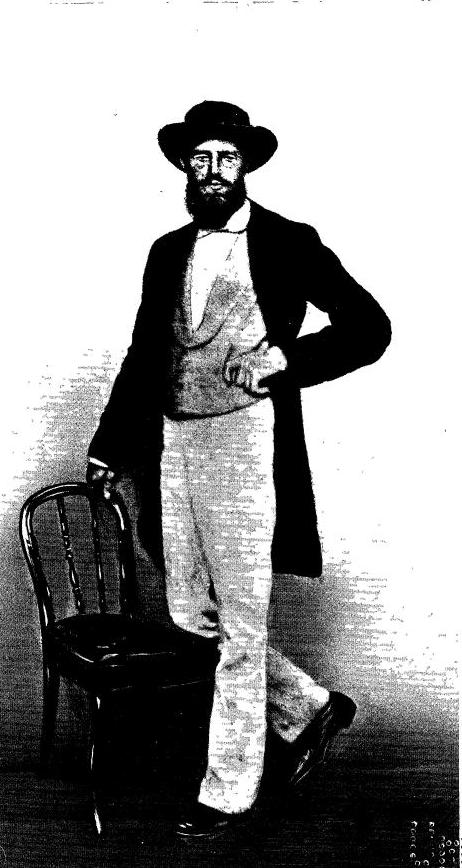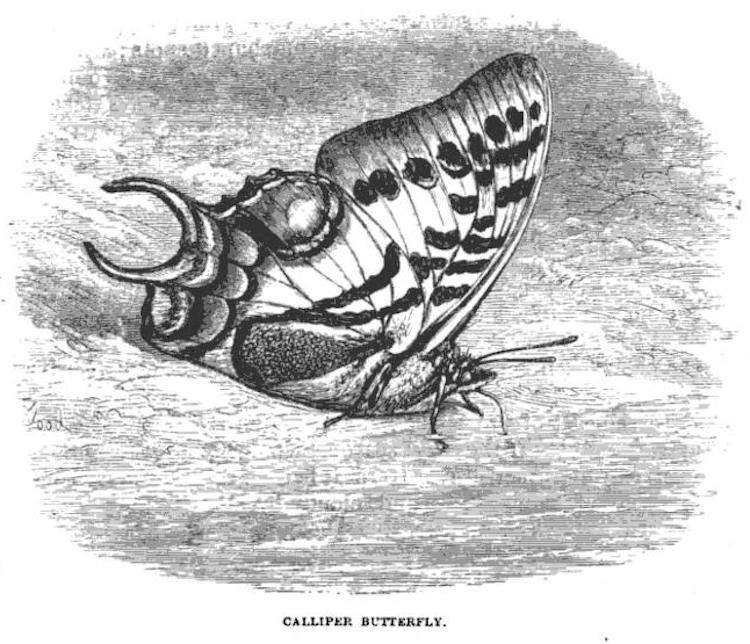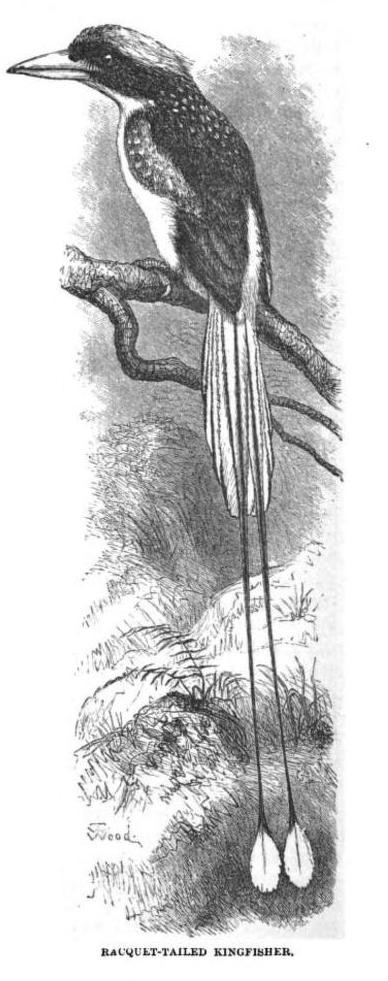
In 1876, Alfred Russel Wallace published a ground-breaking and seminal study entitled The Geographical Distribution of Animals. Charles Darwin himself called it "grand and memorable" (qtd. in Costa 317): it would become, in some vital respects, "the founding document of modern evolutionary biogeography" (Costa 317). Wallace was never a man to give up. Tenacity was one of his hallmarks. He had graciously let Darwin pip him to the post in 1859, by publishing ideas in The Origin of the Species that they had each arrived at independently. But, far from simply slipping back into the shadows, by the mid-1880s he had succeeded Darwin as "the most famous naturalist in Britain" (editors' introduction, p.4).

Wallace in Singapore, 1862. Source: Marchant, facing p. 36.
The Companion is full of such surprises. Born in 1823, Wallace grew up before mid-Victorian authors like Margaret Gatty (Parables from Nature, 1855-71) and Charles Kingsley's Madam How and Lady Why, 1869) began encouraging the young to study the wonders of nature. Yet somehow he became the very model of the youthful apprentice whom Kingsley envisaged, finding inspiration in botany, collecting specimens (especially beetles, after he met the younger naturalist, H. W. Bates), reading voraciously, and passing on his knowledge to others at local mechanics' institutes. Going much further than Kingsley would have expected, Wallace eventually set off on challenging field trips, intent on discovering the links between living organisms he encountered and their environments. This would not be a scattershot project, but a way to get at some fundamental law behind their distribution.
What turned a hobby into such a large-scale, lifetime preoccupation? After the "capsule biography" in the editors' introduction, the first chapter of the Companion, is Charles Smith's "The Early Evolution of Wallace as a Thinker," which helpfully introduces us to the key influences on his intellectual development. Among the more crucial were Robert Owen's idealistic brand of socialism, and Robert Chambers's Vestiges of the Natural History of Creation (1844). Another important item in Wallace's baggage was physical stamina: on his forays, first into Amazonia (1848-52) and then into Southeast Asia (1854-62), he overcame vicissitudes that would have grounded many a weaker spirit, from a disastrous fire at sea that largely destroyed two years' worth of specimens and field-notes, to an eruption of boils all over his body, even in his eye. But he emerged from this long period of adventuring not only intact, but with some amazing collections, and a number of his hunches confirmed — as well as with material for an extraordinary range of talks and writings.

Caliper Butterfly. Source: Wallace 245.
Succeeding chapters of the Companion cover Wallace's research on his travels (for example, his observations and theories about how animals use protective or defensive colouring), his relations with Darwin and other fellow-researchers, and his own views on evolution and natural selection, this last topic discussed clearly and sympathetically here by Sherrie Lyons. His social criticism and his environmental, ecological and biogeographical interests are also analysed in detail. His interests might seem disparate now, in an age of ever-increasing specialisation, but they were all connected in his capacious mind. A good example of this is the way his concern for ordinary working folk led him to pronounce on subjects ranging from land clearances and taxation to immigration, gathered together here in David Collard's chapter on "Land and Economics." In all these areas, much that Wallace was the first or among the first to discuss is still being discussed, indeed hotly debated: why does the zebra have stripes, and what is to be done if immigration threatens to take away jobs? As Collard says, he can sometimes sound "remarkably 'modern'" (253). In the penultimate chapter, Mark Lomolino even puts him at the frontiers of conservation biology.
Some conclusions that Wallace reached from his own observations have now been proved beyond all reasonable doubt – that man has been responsible for causing "recent and imminent extinctions," for example (Lomolino 350); or that, if we fail to "expand our empathy and concern not only for our fellow human beings but for all life on Earth, we will be doomed to extinction" (Lyons 186). When we learn that he "came increasingly to argue that pollution of the atmosphere and and of water was the most important issue facing society" (Collard 268), we are tempted to see him as a prophet as well as a scientist — one, moreover, whose calls to action have not yet been heeded.
Yet the second chapter here, on "Wallace and the 'Preter-normal,'" and the last, entitled "Wallace and Extra-Terrestrial Life," bookend his insights with proof that he was as much a man of his time as a man ahead of his time. In the former, he allows himself to find in spiritualism answers to the puzzles which would not yield satisfactorily to his enquiring mind; in the latter he dismisses out-of-hand the possibility of life-forms on Mars or anywhere else in the universe. These are not contradictory stances: to Wallace, Man was "the one crowning product of the whole cosmic process of life-development," capable of understanding "the hidden forces and motions everywhere at work," and deducing from them "a supreme and over-ruling Mind as their necessary cause" (qtd. in Robert W. Smith, 368). He had never been one for orthodox religion, but he clung to the idea that "some portion of the spirit of the Deity" had been imparted to human beings, giving them uniquely a "higher nature" (qtd. in Fichman 199) — even if, so far, it had not borne much fruit. Like the poet and novelist George Meredith, whose general mind-set was remarkably similar, he was an optimist, and believed that eventually our finer nature would prevail. He refused to lose faith in what he called "the Republic of Humanity" (qtd. in the editors' introduction, p.7).
Wallace's writing is never boring. He had a knack of engaging the reader, and doing so over a whole range of topics. The nine contributors to the Companion have done well to present these topics with the minimum of technical jargon, so that even, say, glaciology (one of the least known of his interests, as Charles Smith admits) becomes comprehensible to the non-specialist. No exaggerated claims are made. Here, for instance, and in the related fields of Geology and Climatology, Wallace's work was not foundational. But his observations could be acute: equally important is the fact that they were so lucidly explained. Moreover, as Charles Smith points out towards the end of his discussion of Wallace and glaciology, he played a valuable role in these early explorations by marshalling the research in these areas, and making it more widely available.

Racquet-tailed kingfisher. Source: Wallace 298.
Nevertheless, Darwin's name has come to dominate all others in the history of evolutionary thinking and its various ramifications. This collection of essays is therefore very likely to serve an additional function to that of most "companions." As well as providing more information for those already familiar with Wallace's work, it will probably bring readers to him for the first time. They will not be disappointed. The editors recommend some full-scale biographies of Wallace at the beginning; they also signpost the brilliant online Wallace Correspondence Project (see the first and last footnotes in the introduction), and include a large selection of his many publications in their almost forty-page list of references at the back. The easiest of his works to acquire in print are The Malay Archipelago (1869) and his later autobiography, My Life: A Record of Events and Opinions (1905), both reprinted recently. But many of the other titles are worth looking up online. Not least by apprising readers of these, the Companion proves itself eminently worthy of this inspiring and wide-ranging polymath.
Related Material
- Alfred Russel Wallace: The Origins of an Evolutionist
- Travels in the Amazon and Malay Archipelago (1848-1862)
- Wallace the Evolving Polymath (1862-1880)
- Wallace the Social Radical and "Grand Old Man of Science" (1880-1913)
- Wallace, On the Law which has Regulated The Introduction of New Species
- Wallace's Accomplishments: A Summary List
- A Wallace Chronology
- Wallace's objections to Francis Galton (a short extract from the Companion)
- Why was Wallace "seemingly fooled" by mediums? (a short extract from the Companion)
- Wallace's contributions to scientific thought (a short extract from the Companion)
Bibliography
[Book under Review] Smith, Charles H., James T. Costa, and David Collard, eds. An Alfred Russel Wallace Companion. Chicago: University of Chicago Press, 2019. 439 pp. ISBN 978-0-226-62210-1. £45.00.
Collard,David. "Land and Economics." Smith et al. 235-73.
Costa, James T. "Historical and Ecological Biogeography." 299-339.
Fichman, Martin. "Wallace as Social Critic, Sociologist, and Societal 'Prophet.'" 191-233.
Lomolino, Mark V. "Wallace at the Foundations of Biogeography and the Frontiers of Conservation Biology." 341-55.
Lyons, Sherrie. "The Many Influences Shaping Wallace's Views on Human Evolution." 167-89.
Smith, Robert W. "Wallace and Extraterrestrial Life." 357-80.
References to Wallace's own writings
Marchant, James. Alfred Russel Wallace: Letters and Reminiscences. Vol. I. London: Cassel, 1916. Internet Archive. Contributed by the University of Michigan. Web. 8 August 2019.
Wallace, Alfred Russel. The Malay Archipelago the Land of the Orangutan, and the Bird of Paradise: A Narrative of Travel with Studies of Man and Nature. Vol. I. London: Macmillan, 1869. Internet Archive. Contriuted by the University of Naples. Web. 8 August 2019.
Created 8 August 2019